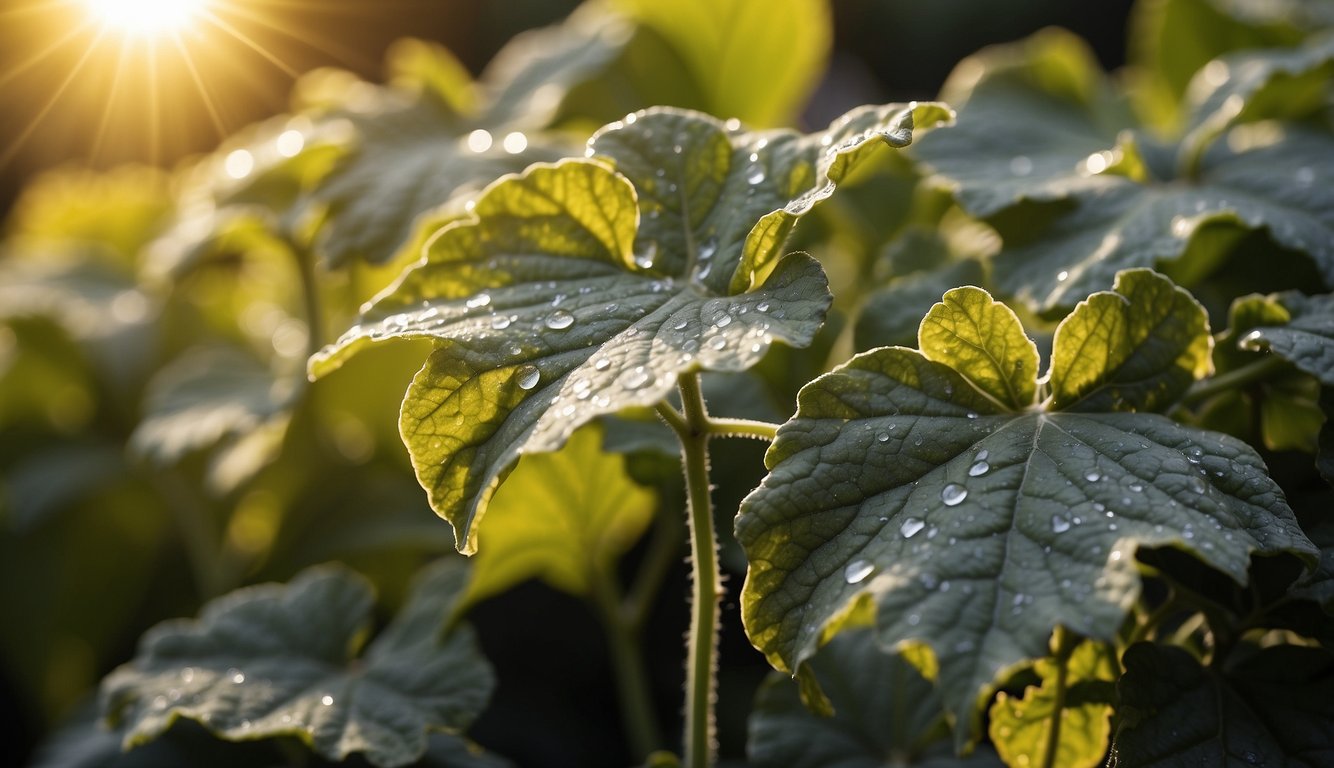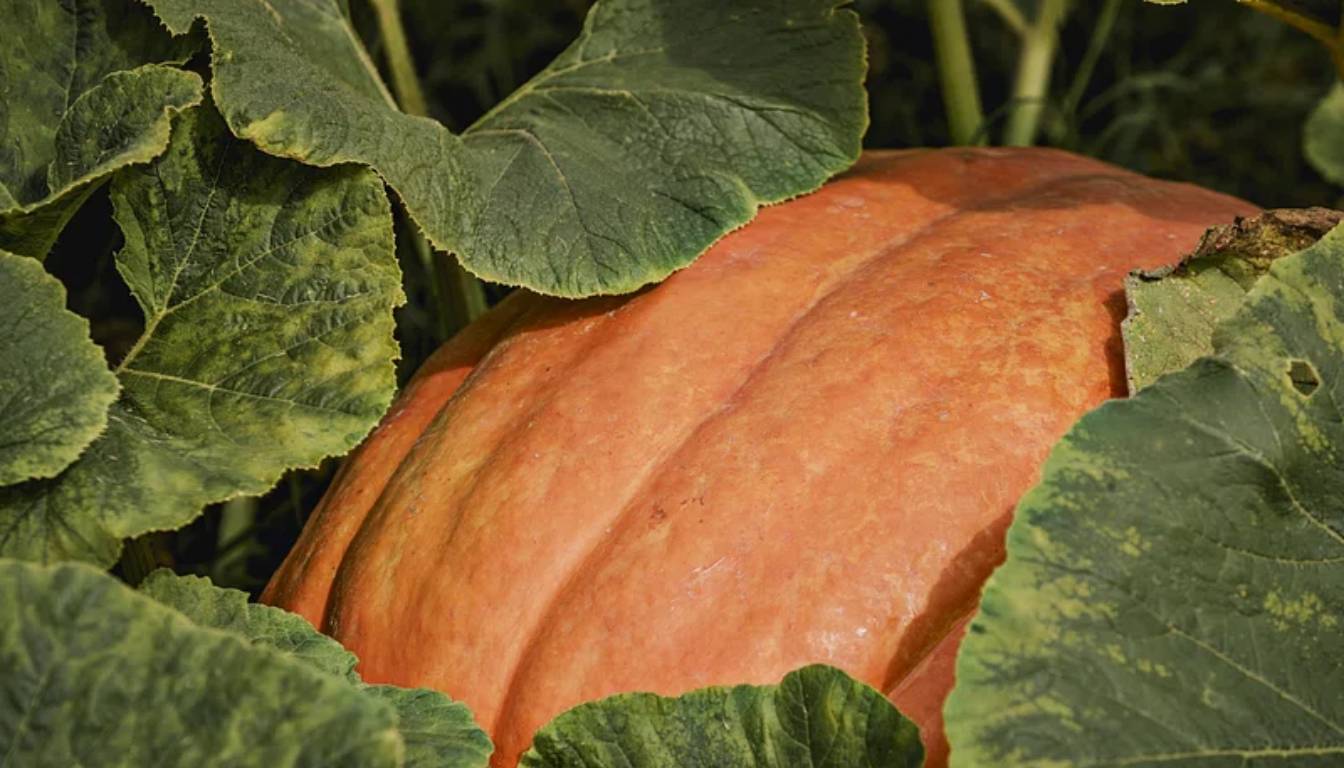Pumpkins are a beloved fall crop, perfect for pies and decorations. However, like any plant, they’re susceptible to diseases. Powdery mildew is a common fungal infection affecting pumpkin plants. It causes white spots on leaves and vines. If untreated, it can lead to the plant’s death. What is the best Pumpkin Fungus Treatment?
Fortunately, there are a variety of treatments available for pumpkin fungus, including fungicides and other disease management strategies. Fungicides can be applied to the affected areas of the plant to kill the fungus and prevent it from spreading. In addition, crop rotation and sanitation can also be effective in preventing the spread of powdery mildew and other fungal infections. By taking steps to manage pumpkin fungus, growers can ensure a healthy and bountiful harvest of pumpkins.
Understanding Powdery Mildew on Pumpkin Plants
Powdery mildew is a foliar disease that affects pumpkin plants, causing white spots to appear on the foliage. It is a fungal disease that thrives in high humidity and warm temperatures, making it a common problem during the summer months. In this section, I will discuss the conditions that favor infection and how to distinguish between powdery and downy mildew.
Conditions That Favor Infection – Pumpkin Fungus Treatment
Powdery mildew infection is favored by high humidity and warm temperatures, typically between 60 and 80 degrees Fahrenheit. The fungus thrives in humid conditions and can spread rapidly through the pumpkin plant’s leaves and vines. Wind can also spread the spores of the fungus to other plants, making it important to maintain good air circulation around the plant.
Full sun can help prevent powdery mildew infection, as the fungus prefers shady and humid conditions. However, too much sun can also stress the plant, making it more susceptible to other diseases and pests. Watering the plant from above can also promote powdery mildew infection, as the leaves and fruit can remain wet for too long, creating the perfect environment for fungi to grow.
Distinguishing Between Powdery and Downy Mildew
Powdery mildew and downy mildew are both fungal diseases that can affect pumpkin plants, but they have different symptoms. Downy mildew appears as yellow or brown spots on the leaves, while Powdery mildew appears as white spots on the foliage. Powdery mildew also thrives in dry conditions, while downy mildew prefers wet conditions.
Powdery mildew is a common foliar disease that affects pumpkin plants during the summer months. It thrives in high humidity and warm temperatures, making it important to maintain good air circulation and avoid watering the plant from above. By understanding the conditions that favor infection and how to distinguish between powdery and downy mildew, you can take steps to prevent and treat this fungal disease.
Treating Powdery Mildew on Pumpkins – Pumpkin Fungus Treatment
As a gardener, I understand the frustration of dealing with powdery mildew on pumpkins. However, with proper treatment, it is possible to manage this fungus and prevent it from spreading. In this section, I will discuss a few effective ways to treat powdery mildew on pumpkins.
Removing the Fungus – Pumpkin Fungus Treatment
The first step in treating powdery mildew on pumpkins is to remove any infected leaves, vines, or blossoms. This will help prevent the fungus from spreading to other parts of the plant. It is important to dispose of the debris properly to avoid contaminating the soil.
Utilizing Organic and Home Remedies
Cultural practices such as pruning and weed management can also help prevent the spread of powdery mildew. Additionally, organic remedies such as neem oil, milk, and sulfur are effective in managing powdery mildew on pumpkins. Neem oil and milk can be sprayed directly on the infected leaves, while sulfur can be applied to the soil to prevent the fungus from growing.
Applying Conventional Fungicides
If the powdery mildew on the pumpkins is severe, it may be necessary to use conventional fungicides. Fungicides such as mancozeb and copper can be effective in managing powdery mildew on pumpkins. It is important to follow the instructions on the fungicide label and apply it at the recommended frequency.
Treating powdery mildew on pumpkins requires a combination of cultural practices, organic remedies, and conventional fungicides. By following these methods, it is possible to manage the fungus and prevent it from spreading to other plants in the garden.
Preventing Future Infections – Pumpkin Fungus Treatment
As a gardener, it’s important to take preventative measures to avoid future pumpkin fungus infections. Here are some cultural controls and good gardening practices to consider:
Cultural Controls and Good Gardening Practices
- Crop Rotation: It’s important to rotate crops every year to prevent the buildup of soil-borne diseases. Avoid planting pumpkins in the same location for at least two years to reduce the risk of fungal infections.
- Air Flow: Good airflow is essential for preventing fungal diseases. Plant pumpkins in an area with good air circulation and avoid overcrowding. This will help to reduce humidity levels and prevent the development of fungal spores.
- Sunscald: Excessive sun exposure can cause sunscald on pumpkins, which can create an entry point for fungal infections. Provide shade for pumpkins during the hottest part of the day to prevent sunscald.
- Mulch: Mulching can help to prevent fungal diseases by reducing soil splash and keeping the soil evenly moist. Use a layer of organic mulch around the base of the pumpkin plants.
- Autumn Cleanup: Remove all plant debris at the end of the growing season to prevent the overwintering of fungal spores.
Planting Resistant Varieties
Planting resistant varieties is another effective way to prevent fungal infections. Look for varieties that have partial resistance to common pumpkin diseases such as powdery mildew and downy mildew. This can help to reduce the severity of infections and increase yield.
Following these cultural controls and good gardening practices can help to prevent future pumpkin fungus infections. By rotating crops, providing good airflow, preventing sunscald, using mulch, and planting resistant varieties, gardeners can enjoy a bountiful pumpkin harvest without the risk of fungal diseases.
Before You Go – Pumpkin Fungus Treatment

Managing pumpkin fungus is crucial to ensure a healthy pumpkin crop and a high yield. Through comprehensive research and analysis, I have gathered valuable information on the different types of pumpkin fungi, their causes, and treatment options.
It is important to note that early detection is key to successfully treating pumpkin fungus. Regular scouting and monitoring of pumpkin crops is necessary to identify any signs of infection. Once identified, it is important to take immediate action to prevent the spread of the fungus.
There are several treatment options available, including chemical and organic fungicides. It is important to choose the right treatment for the specific type of fungus and the severity of the infection. Authoritative content on the use of fungicides should be consulted before application.
Failure to manage pumpkin fungus can result in reduced yield and even total crop loss. However, a mild case of pumpkin fungus can be easily treated with the right fungicide and proper application.
Managing pumpkin fungus requires knowledgeable and proactive measures. Regular scouting, early detection, and proper treatment are key to ensuring a healthy pumpkin crop and a high yield.
Pumpkin Fungus Treatment: A Herbalist’s Guide
Today, we’re tackling a common garden problem – pumpkin fungus. Yes, even our beloved pumpkins can fall victim to fungus. But don’t worry, I’ve got some tips for pumpkin fungus treatment!
First off, let’s talk about why treating pumpkin fungus is important. It’s simple – it helps keep your pumpkins healthy and thriving! Plus, it’s a great way to ensure a bountiful harvest.
Now, let’s tie this back to theherbprof.com. As your friendly neighbourhood Herbalist Blogger, I’m all about helping you nurture your garden. And treating pumpkin fungus? It’s a crucial part of this journey!
By treating pumpkin fungus, you’re not just saving your pumpkins. You’re also embracing the principles of organic gardening, a topic I’m passionate about and often discuss on my blog, theherbprof.com.
So, why not give it a try? Arm yourself with knowledge, roll up your sleeves, and tackle that pumpkin fungus head-on. Your pumpkins (and your harvest) will thank you!
References – Pumpkin Fungus Treatment
Little Herb Encyclopedia, by Jack Ritchason; N.D., Woodland Publishing Incorporated, 1995
The Ultimate Healing System, Course Manual, Copyright 1985, Don Lepore
Planetary Herbology, Michael Tierra, C.A., N.D., Lotus Press, 1988
Handbook of Medicinal Herbs, by James A. Duke, Pub. CRP Second Edition 2007
The Complete Medicinal Herbal, by Penelope Ody, Published by Dorling Kindersley
Check the Following Articles!
Grow Carrots in Bag: An Efficient Guide for Beginners
How to Successfully Grow Mint Leaves Indoors?
Growing Spearmint Indoors: Tricks for a Successful Harvest
Do Rabbits Eat Rhubarb? The Truth About Consumption
Frequently Asked Questions – Pumpkin Fungus Treatment
1. What natural remedies are effective for treating fungal infections in pumpkin plants?
There are several natural remedies that can be used to treat fungal infections in pumpkin plants. One effective remedy is a mixture of baking soda and water. This solution can be sprayed directly onto the leaves and stems of the plant to help control the spread of the fungus. Another natural remedy is neem oil, which can be used to combat fungus on pumpkin vines. Additionally, some gardeners have found success using a mixture of milk and water to treat fungal infections.
2. How can neem oil be used to combat fungus on pumpkin vines?
Neem oil is a natural fungicide that can be used to combat fungus on pumpkin vines. To use neem oil, mix it with water and spray it directly onto the affected areas of the plant. The oil works by disrupting the life cycle of the fungus, preventing it from reproducing and spreading further.
3. What are the most effective fungicides available for pumpkin disease control?
There are several effective fungicides available for pumpkin disease control. Some of the most commonly used fungicides include copper-based products, sulfur-based products, and chlorothalonil. It is important to follow the instructions on the label carefully when using these products, as overuse can lead to damage to the plant.
4. How can baking soda be utilized as a treatment for pumpkin fungus?
Baking soda can be utilized as a treatment for pumpkin fungus by mixing it with water to create a solution that can be sprayed onto the plant. The baking soda works by altering the pH level of the plant, making it more difficult for the fungus to survive. It is important to note that baking soda can also be harmful to the plant if used in excess, so it is important to follow the instructions carefully.
5. Can you provide a guide to identifying common pumpkin diseases with pictures?
Yes, there are several resources available online that can help gardeners identify common pumpkin diseases with pictures. One such resource is the University of Illinois Extension website, which provides a comprehensive guide to pumpkin diseases with pictures.
6. What steps should be taken to treat fungus on squash plants, which may be similar to pumpkins?
The steps to treat fungus on squash plants are similar to those for pumpkins. Some effective treatments include using a fungicide, such as copper-based products or sulfur-based products, and ensuring that the plant has adequate air circulation and sunlight. It is also important to remove any infected leaves or stems from the plant to prevent the spread of fungus.

